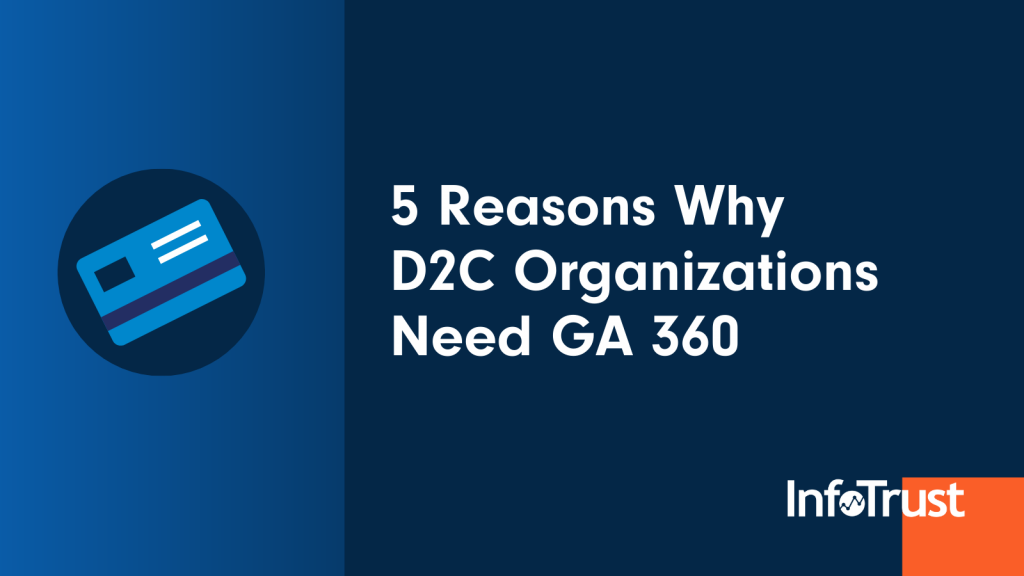It’s 2020 and the Direct-to-Consumer (D2C) market continues to grow, despite recent events. With a sales forecast of $17.75 billion for total eCommerce sales of 2020, D2C organizations aren’t going anywhere anytime soon. Along with the recent events taking a toll on numerous household retail names, this time is the perfect opportunity for D2C brands to find new audiences and grow.
For these organizations to conquer new markets, it’s imperative that they have a proper analytics implementation and architecture to track all website behavior. Free analytics platforms like Google Analytics are available to gain basic insights but have extensive limits to their platform. To have a true 360 view (no pun intended) of your customers, investing in a premium analytics platform can give your organization a competitive edge.
As one of Google’s top premier analytics partners, we work with many retail & e-commerce clients to get the most out of their Analytics 360 license. Based on work with D2C Organizations like Lovevery, Backcountry.com, and Overstock.com, we compiled a list of the Top 5 reasons why D2C organizations need to invest in Google Analytics 360.
1. Expanded Custom Dimensions & Metrics
Every organization has different KPIs or indicators to measure and track weekly/monthly goals. Of course, there are the standard indicators that many organizations need to track, such as changes in revenue or website traffic, but the beauty of analytics is that we have the possibility to track hundreds of thousands of metrics. For example, a D2C clothing brand may want to track which day saw the highest revenue brought in for a particular shirt.
With a free platform like Google Analytics, you’re limited to 20 custom metrics and dimensions. This means you have some ability to track KPIs that matter to your business, but due to the limited number, you’d have to prioritize which ones mean more to your business at that time.
With Google Analytics 360, that number increases by tenfold (200 custom dimensions & metrics each)! This means you have more access to create and track the KPIs that matter most to your business and can more efficiently and effectively reach your customers. A few examples include:
- Tracking when someone reviews a product on that product’s page
- Analyzing which products are added to wish lists the most
- Understanding different user attributes i.e. are they first-time buyers or a member?
2. Integration and Full Visibility on Marketing and Paid Media
If any retail/eCommerce products are to reach the mass population, marketing teams must push their company offerings through different advertising channels to demonstrate their value and reach as many potential customers that they can. An article from ZoomInfo about 50 essential multichannel marketing statistics found that 51% of organizations used at least eight different marketing channels to reach their target audience.
With all these campaigns executing across channels, it can be difficult to steadily collect and analyze the data to understand the most successful campaigns that have the highest return on ad spend (ROAS). That’s where GA 360 comes in.
GA 360 is one component of the Google Marketing Platform, the rest being made up of different analytics and media products. Google’s media products are used to help create and implement strong search marketing and media campaigns (Search Ads 360 & Display and Video 360, respectively), as well as optimize their trafficking and reporting capabilities (Campaign Manager).
Since all of these products are part of the same “family”, there is a native integration between the media platforms and Google Analytics 360. With this integration, data from all of the media products are able to flow into Analytics 360. This allows the analysts to see not only the advertising figures but also site usage and engagement for traffic coming from different advertising channels in a clean and user-friendly manner. My colleague, Ariel Opelt, speaks beautifully to the key techniques that can be used by D2C organizations to drive remarketing audiences via GMP here.
3. Unsampled Export to BigQuery for Customer Lifetime Value Modeling and Predictive Analytics
Every retailer/eCommerce organization is trying to find their most valuable customers to drive customer lifetime value for the organization. It makes sense to do so since returning shoppers spend 3x the amount that first-time shoppers did and accounted for 1/3rd of the dollars spent on eCommerce in 2018, according to Medium.com. In order to understand who belongs in that grouping, companies need to collect as many data points (i.e. purchase history, interactions with the website/products, etc.) as possible about their consumers and use that to target their highest spenders.
However, analytics platforms can only collect and store a limited amount of data at a time, some even restricting the amount of raw data teams are able to analyze (Google Analytics free as an example). Due to this limitation, it can be difficult to have a full understanding of who the most profitable spenders are for the organization.
With cloud computing and storage platforms, like Google’s BigQuery, analysts have the ability to import and export raw, unsampled data about their consumers, where it can be used for further and deeper analysis. BigQuery takes it one step further by giving users the ability to perform real-time analysis on fresh data, allowing organizations to understand their shoppers as live data is populated.
Because BigQuery is able to store an immense amount of data and run queries/analysis in realtime, advertisers can find custom cohorts to personalize their marketing and drive incremental sales. After creating audiences in BigQuery, those audiences can be exported to Google Analytics 360 via the measurement protocol. Here is a case study on Customer LifeTime Value and Custom Cohort Analysis to bring this value to life.
4. Advanced ROI Analysis for Multi-Channel Funnels and Attribution
One of the reasons organizations collect and analyze data is to understand the consumer’s journey throughout their buying process. As an advertiser, we want to know what touchpoints it took to get our customers from top of funnel to completing the purchase.
Unfortunately, we still see solutions giving the credit to the last click, meaning that any steps that came before would not receive attribution credit, making it difficult to track how our customers arrived at the purchase.
With Attribution 360 in Google Analytics, business users have the ability to generate custom models of their customer’s journies and assign touchpoints to certain steps across the purchase funnel (i.e. display, organic search) that play a key role in the conversion process. From here, companies have the ability to see what campaigns were involved in the purchase and how long it took (did the conversion happen in a day or did it take a couple of weeks).
Users are able to easily track and analyze these conversions through the Multi-Channel Funnel (MCF) reports. These reports show not only the total number of conversions but how much each marketing channel contributed to the conversions and where they overlapped. With these reports, the organization’s marketing team will be able to visualize how all the channels are doing, thus helping better allocate and invest in future campaigns
5. Dedicated Service Level Agreement Support
No matter how large or experienced an organization’s team is with an analytics platform, there are going to be times where certain situations will occur and will require help from experts of that platform. The problem is a lot of these free platforms’ version of help is a “help desk” that users have to reach out to and wait for a response in the order that it was received. Some of the top paid analytics platforms may offer a dedicated team to these businesses but will bill them for hourly rates and cap them off once the quota is hit. That’s not the support any company wants.
With Google Analytics 360, organizations receive dedicated SLA support both from Google and typically from the partner who is reselling the license to them. The help from these partners doesn’t just entail product support of Google Analytics 360 (& Google Tag Manager 360), but can also include bi-weekly/weekly meetings to ensure needs are met and to share any powerful insights that can bring a higher ROAS or reduce the cost of acquisition.
When looking for a partner, there are many factors that should be considered. Asking if the support comes with a dedicated team, how they demonstrate knowledge by sharing regular content and best practices, and if they offer customized training tailored to the team’s needs are just a few of the numerous questions that should be answered during the search for the ideal partner.
If you’re currently searching for a Google Certified Partner and want to know what to consider, check out our Google Analytics 360 Sales Partner Checklist.
Conclusion
Above are just a few of the numerous reasons why D2C organizations should invest in a premium analytics platform like GA360. With it, you’ll have the ability to:
- Better understand your user’s interactions with your site
- Gain a 360 perspective of how your paid marketing efforts are playing in the journey
- Store more raw data that can be used to determine who the best customers are for your business
- Learn and implement powerful findings that are shared from the “extension of your team”
If you are still curious and want to learn more about whether GA 360 is right for you, consider discussing these ten questions amongst your team about the benefits and the investment of the platform, as well as where you are as an organization. Additionally, you can reach out to us by clicking here to talk discuss priorities and questions around GA 360 for your organization.


